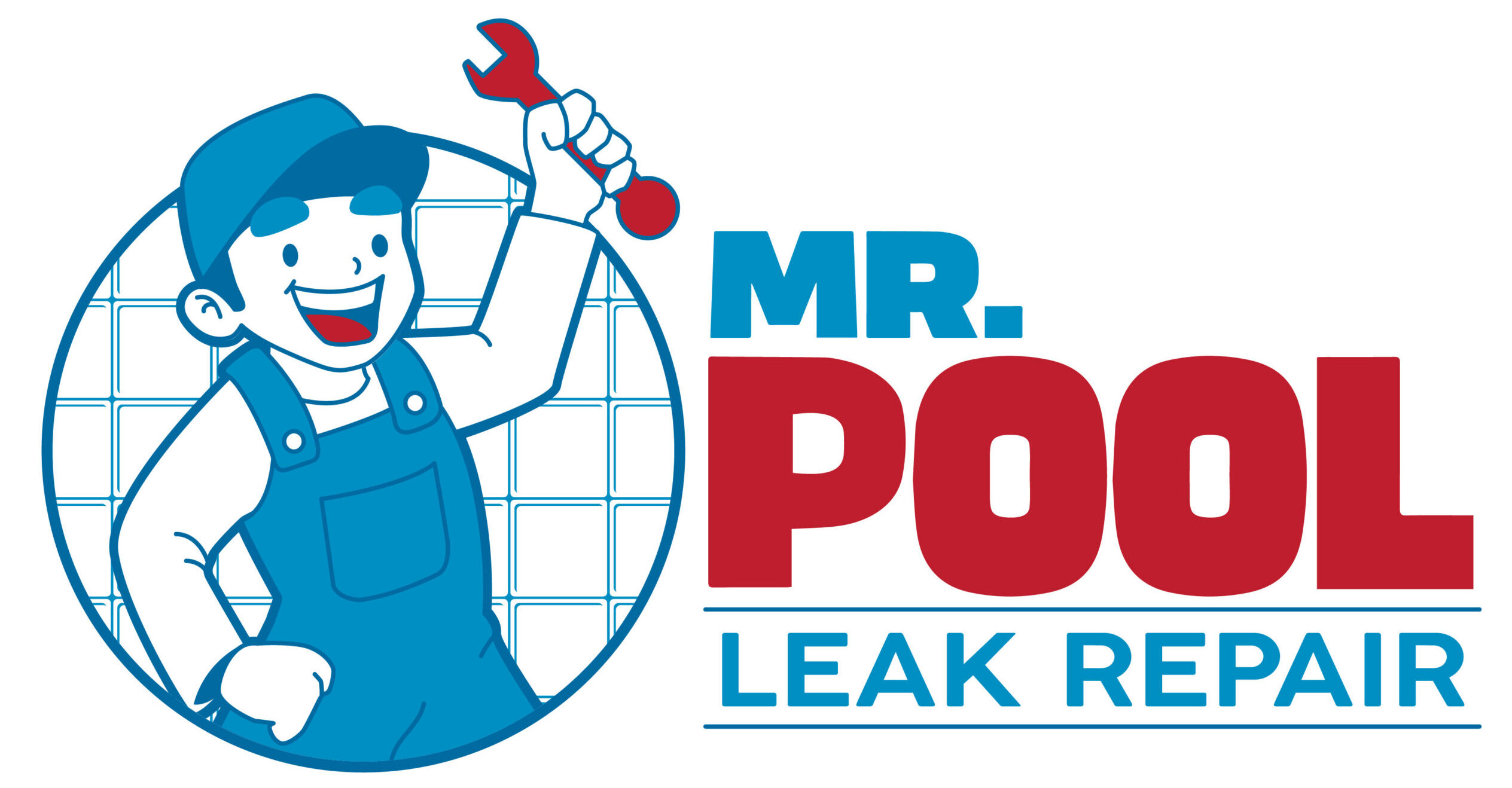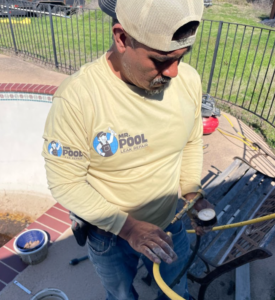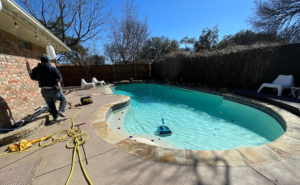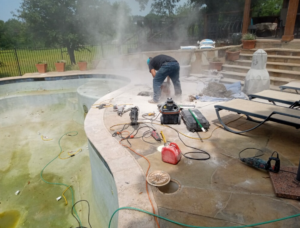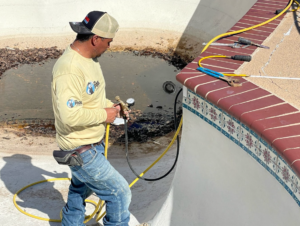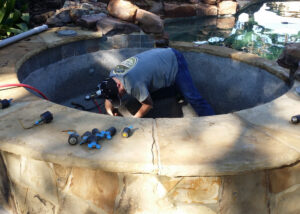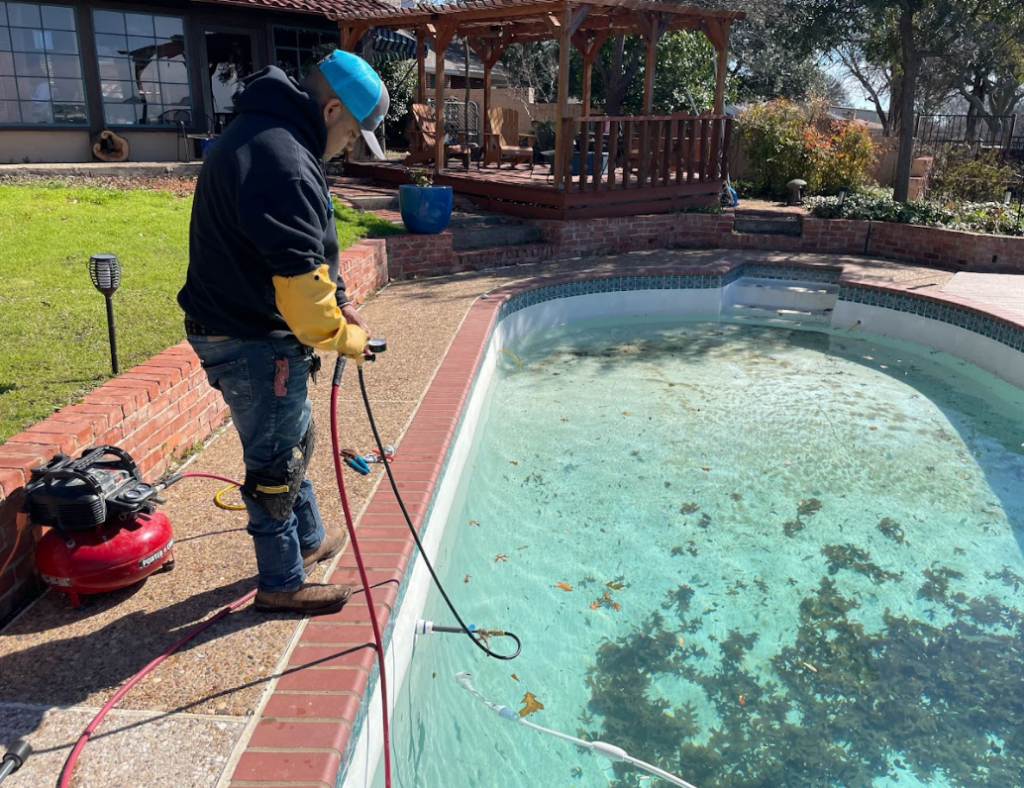
Regular maintenance is a crucial aspect of owning a swimming pool, and having a comprehensive guide to pool maintenance is invaluable. Whether you own an Intex, Above Ground, Intex, or Saltwater pool, understanding the essentials of pool maintenance can make a significant difference. By familiarizing yourself with how your pool works, how to maintain it properly, and how to effectively plan for upkeep, you’ll be equipped to tackle any pool issue that arises. This guide to pool maintenance aims to provide you with the foundational knowledge needed to keep your pool in top condition.
Contact Us
Knowing Your pool is the first step to good pool maintenance
Guide to Pool Maintenance: You may need to refresh your knowledge of all the components in your pool before you can enjoy it or properly care for it. Understanding the functions of each part in your pool will help you maintain a smooth operation and resolve any issues that may arise.
Leaks are no more! Our team of experts will tackle pool leaks and streamline your swimming pools maintenance. Learn how to take care of your pool with The Pool Repair Service. Our guidance will help you maintain crystal clear water throughout the season, ensuring a seamless and dry swimming experience.
The Basic Components Of A Swimming Pool
Four components of every type of pool require regular maintenance. The four components are:
1. Pool Water
Guide to Pool Maintenance: water in your swimming pool may seem obvious, but it is the key to a long-lasting pool. It protects your family and you from pollutants and contaminants by keeping it clear and balanced. This will also help you to avoid expensive hardware repairs caused by corrosion or mineral accumulation, and it will make your pool last longer.
2. Pool Interior
Your pool liner is constantly in contact with the water and anything that enters your pool. Keep these surfaces clean, free of mold and algae.
3. Pool Filter System
Your pool’s pumping heart is also its liver. It sounds strange, but it’s true. Think about it. Your pool pump circulates your water, just like your heart does. Your pool filter removes dirt, bacteria and other contaminants in your water much like your liver does with your blood.
Both will protect both you and your swimming pool. Your pool will become a polluted mess without a working filter system.
You may have a cartridge, sand, or diatomaceous Earth (D.E. filter. If you have a system that uses salt water, you can use a chlorinator.
4. Pool Skimmers & Returns
Guide to Pool Maintenance: Your skimmers, not to be confused with a net skimmer (the cleaning tool attached to a telescoping pole), pull water into the filter for cleaning. The returns push the cleaned water back into your pool. The skimmers, which are not to be confused with the net skimmer (the cleaning tool attached to the telescoping rod) pull water into the filter to clean it, while the returns push back the cleaned water into your pool. Like your veins or arteries, skimmers work best when they are clean and free of obstructions.
As time passes, you will no doubt face pool maintenance challenges that are specific to your pool. If you have a good understanding of these four components, you will be able to tackle most pool maintenance challenges.
Three C’s of Proper Pool Care
Three simple, but essential concepts are the foundation for effective pool maintenance: circulation, cleaning and chemistry.
1. Good Water Circulation
Moving water in your pool is safer, cleaner and clearer. The key to a healthy and safe pool is proper circulation.
When there is good circulation in a pool, problems like algae or cloudy water are rare. To maximize circulation, keep your filter and pump running every day.
How long should your pool pump run? Ideal is to run your pool pump 24 hours per day, seven days a week. We recommend that your filter runs at least 10-12 hours per day, but we understand this is not possible for all budgets or equipment. This will help to keep your pool clean and safe by turning the water a few more times.
Backwashing your filters is another important component of good pool circulation. Backwashing is the process of reversing water flow through the filter, transferring dirty water and contaminants into the waste port and out of the pool.
It’s important to know how to clean your pool filter and to make this part of the routine pool maintenance.
Add a cup D.E. Powder can boost the filtering ability of your pool. D.E. powder will help clear up cloudy water more quickly. Your sand filters will strain out fine particles with the help of your D.E.
2. The Pool Cleaning Schedule
You’ve made the cleaning of your pool easier if it is properly circulated. You’ll need to put in some elbow grease. You’ll need the following basic tools:
- Net skimmer
- Pool brush
- Pool vacuum
Mother Nature, as well as the people who use your pool, bring in all kinds of weird and wonderful things, including leaves, mold and even the occasional duck or frog, to residues left behind by shampoos, hair products, and perfumes. Cleaning your pool is essential for safe swimming, especially when you consider the risk of bacterial contamination.
Weekly, you should brush, skim and vacuum your swimming pool. It will keep the water clean and debris out. Baking soda paste is a great basic cleaner. It won’t harm delicate tiles or vinyl liners when you use it.
A pool cleaner that works automatically can reduce your pool cleaning time. The automatic pool cleaner will not eliminate the need to regularly skim and brush, but it will make both tasks much easier. This allows you to spend more time in your pool.
You can make cleaning your pool easier by adding a few unconventional items to it. Tennis balls will absorb the surface oils from suntan lotions and cosmetics. Wrap your skimmer’s baskets in pantyhose for a finer filter. This will catch more contaminants that a skimmer.
Replace both the tennis ball and the pantyhose as soon as they show signs of wear.
Tip: The drains in the bottom of your inground pool will pull water to the filter, making it easier for you to remove debris that has been loosened while cleaning. These drains are not available for above-ground pools, but a manual vacuum can provide the same boost to water clearing.
Attach your vacuum to the filter system, and then place it at the center of your above-ground pool. Make sure that the vacuum is facing up. It will act as a drain when you turn it on.
3. Balancing Your Water Chemistry
Bunsen burners should be avoided. You don’t need to be concerned about pool chemistry, even though it may seem intimidating. Basic pool chemistry can be a simple and effective way to maintain your pool.
Water testing kit is the most important tool you can have in your arsenal of water care tips. You wouldn’t taste your stew before seasoning it. Do some pool water tests before reaching for the chemicals. The first step in balancing your pool water is to understand what’s there and what’s not.
Three Important Components of Pool Water Chemistry Include:
pH: A measure of the acidity or basicity of your pool water. High pH levels are basic, while low levels are acidic. Ideal pH range for your pool: 7.4 to 7.6
Alkalinity acts as a buffer for pH and prevents large spikes in acidity or basicity. The range of 100-150 parts per million is ideal. You can also use baking soda to raise the alkalinity of your pool.
Levels of sanitizers: the amount of bromine, chlorine, etc. Your pool water. The correct levels will vary depending on the type of sanitizer that you use.
You can add chemicals to your water to adjust the pH, alkalinity and sanitizer level once you have determined your levels. Follow all directions and make sure to understand what each chemical will do and how it will affect the water and people who swim in it before adding it.
Don’t forget to add pool shock!
Your sanitizer may need some help every now and then, especially if you have had a heavy rainstorm or many people using the pool. Add pool shock to your pool on a regular schedule to keep it clean, even when the sanitizer has been maxed out.
Contact Us
Create a Maintenance Schedule
Your to-do lists might seem daunting as you become more familiar with your pool. A pool maintenance schedule helps you stay organized, and ensures that important tasks are not missed.
You’ll not only be able stay on top basic maintenance, but also plan ahead to complete more advanced tasks such as closing your swimming pool, taking care of it in the off-season, or getting ready for pool season.
Keep it simple
You can tape your schedule of pool maintenance on your wall, your fridge or anywhere near your pool. Write down the names of those who are available to help with the maintenance on specific days.
Three Tips for Pool Maintenance
Since most of our readers enjoy summer vacations, and many own swimming pools as well, I thought I’d share some tips on how to maintain your pool while you are away. This question was asked a lot to me when I worked in the pool store. It’s actually not as difficult as you may think.
1. Find a neighbor or a friend
Keep your pool clean when you are away.
Ideal candidate would be someone who already owns a swimming pool. The person should know exactly what to do. You can give your neighbor or friend a simple list of things to do, such as:
- Empty your skimmer baskets
- The pool surface can be skimmed
- Check the filter pressure.
- Use a test kit or test strips to test the water.
- Add any chemicals necessary (only if you know what you’re doing).
2. Buy A Pool Pump Timer
Your pump should already have a timer. I’d recommend investing in one if you don’t have one. These are an essential part of pool maintenance.
Set the timer for the pool to run at least 8-12 hours per day. It’s great if you can divide up the time! It won’t matter if it runs 24 hours per day. It’s important to run your filter and pump to keep your swimming pool clean. A timer is a better option than a person to do this.
3. Check your water before you go
Guide to Pool Maintenance: Bring a small sample of pool water to a local pool store for specialized testing.
When you have it checked, make sure you fix any problems before you leave. Make sure your pH, alkalinity and sanitizer levels are balanced.
- pH: 7.4 to 7.5
- Alkalinity 100 parts per millions (ppm) up to 150 ppm. 125 ppm is ideal.
- Calcium Hardness: 225ppm or 200ppm or 275ppm for concrete pools and plaster pools
- Chlorine Pools – 1 ppm – 3 ppm
- For Bromine Pools : 3 ppm – 5 ppm
- Biguanide Pools – 30 ppm – 50 ppm
- Salt Water Pools – 0.5 ppm chlorine
- Mineral System Pools: 0.5ppm of Chlorine
Make sure that your pool is crystal clear and clean before you depart.
The water is fine, so come on in!
Swimming pools are a great way to have fun in the sunshine at home. It’s true that it requires regular maintenance, but you don’t have to spend the rest of your life with a vacuum cleaner or a chemistry set.
You might even take pride in your ability to care for your pool when you understand how it works, what care is needed and plan ahead. Regular and thorough maintenance will not only allow you to enjoy your swimming, but also give you peace of mind.
